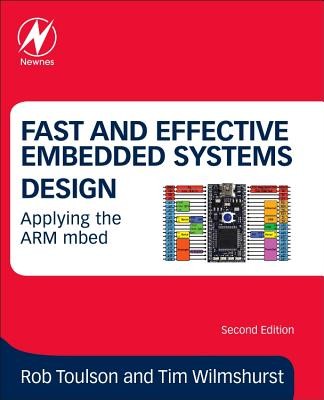
- We will send in 10–14 business days.
- Author: Tim Wilmshurst
- Publisher: Newnes
- ISBN-10: 0081008805
- ISBN-13: 9780081008805
- Format: 19.1 x 23.5 x 2.6 cm, minkšti viršeliai
- Language: English
- SAVE -10% with code: EXTRA
Reviews
Description
Fast and Effective Embedded Systems Design is a fast-moving introduction to embedded systems design, applying the innovative ARM mbed and its web-based development environment. Each chapter introduces a major topic in embedded systems, and proceeds as a series of practical experiments, adopting a "learning through doing" strategy. Minimal background knowledge is needed to start. C/C++ programming is applied, with a step-by-step approach which allows you to get coding quickly. Once the basics are covered, the book progresses to some "hot" embedded issues - intelligent instrumentation, wireless and networked systems, digital audio and digital signal processing. In this new edition all examples and peripheral devices are updated to use the most recent libraries and peripheral devices, with increased technical depth, and introduction of the "mbed enabled" concept.
Written by two experts in the field, this book reflects on the experimental results, develops and matches theory to practice, evaluates the strengths and weaknesses of the technology and techniques introduced, and considers applications in a wider context.
New Chapters on:
- Bluetooth and ZigBee communication
- Internet communication and control, setting the scene for the 'Internet of Things'
- Digital Audio, with high-fidelity applications and use of the I2S bus
- Power supply, and very low power applications
- The development process of moving from prototyping to small-scale or mass manufacture, with a commercial case study.
EXTRA 10 % discount with code: EXTRA
The promotion ends in 23d.19:08:11
The discount code is valid when purchasing from 10 €. Discounts do not stack.
- Author: Tim Wilmshurst
- Publisher: Newnes
- ISBN-10: 0081008805
- ISBN-13: 9780081008805
- Format: 19.1 x 23.5 x 2.6 cm, minkšti viršeliai
- Language: English English
Fast and Effective Embedded Systems Design is a fast-moving introduction to embedded systems design, applying the innovative ARM mbed and its web-based development environment. Each chapter introduces a major topic in embedded systems, and proceeds as a series of practical experiments, adopting a "learning through doing" strategy. Minimal background knowledge is needed to start. C/C++ programming is applied, with a step-by-step approach which allows you to get coding quickly. Once the basics are covered, the book progresses to some "hot" embedded issues - intelligent instrumentation, wireless and networked systems, digital audio and digital signal processing. In this new edition all examples and peripheral devices are updated to use the most recent libraries and peripheral devices, with increased technical depth, and introduction of the "mbed enabled" concept.
Written by two experts in the field, this book reflects on the experimental results, develops and matches theory to practice, evaluates the strengths and weaknesses of the technology and techniques introduced, and considers applications in a wider context.
New Chapters on:
- Bluetooth and ZigBee communication
- Internet communication and control, setting the scene for the 'Internet of Things'
- Digital Audio, with high-fidelity applications and use of the I2S bus
- Power supply, and very low power applications
- The development process of moving from prototyping to small-scale or mass manufacture, with a commercial case study.


Reviews